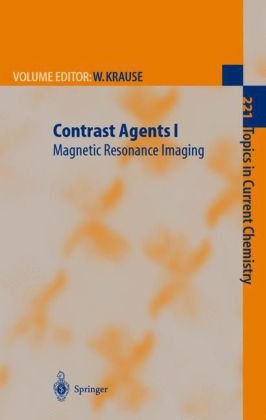

Most ebook files are in PDF format, so you can easily read them using various software such as Foxit Reader or directly on the Google Chrome browser.
Some ebook files are released by publishers in other formats such as .awz, .mobi, .epub, .fb2, etc. You may need to install specific software to read these formats on mobile/PC, such as Calibre.
Please read the tutorial at this link: https://ebookbell.com/faq
We offer FREE conversion to the popular formats you request; however, this may take some time. Therefore, right after payment, please email us, and we will try to provide the service as quickly as possible.
For some exceptional file formats or broken links (if any), please refrain from opening any disputes. Instead, email us first, and we will try to assist within a maximum of 6 hours.
EbookBell Team

5.0
58 reviews
ISBN 10: 3642075967
ISBN 13: 978-3642075964
Author: Werner Krause
Extracellular MRI and X-ray contrast agents are characterized by their phar- cokinetic behaviour.After intravascular injection their plasma-level time curve is characeterized by two phases. The agents are rapidly distributed between plasma and interstitial spaces followed by renal elimination with a terminal half-live of approximatly 1–2 hours. They are excreted via the kidneys in unchanged form by glomerular filtration. Extracellular water-soluble contrast agents to be applied for X-ray imaging were introduced into clinical practice in 1923. Since that time they have proved to be most valuable tools in diagnostics.They contain iodine as the element of choice with a sufficiently high atomic weight difference to organic tissue. As positive contrast agents their attenuation of radiation is higher compared with the attenuation of the surrounding tissue. By this contrast enhancement X-ray diagnostics could be improved dramatically. In 2,4,6-triiodobenzoic acid derivatives iodine is firmly bound. Nowadays diamides of the 2,4,6-triiodo-5-acylamino-isophthalic acid like iopromide (Ultravist, Fig. 1) are used as non-ionic (neutral) X-ray contrast agents in most cases [1].
1 Introduction
2 Metal Chelates as MRI Contrast Agents
2.1 Gadolinium Complexes
2.2 Chelates with Acyclic Ligands
2.2.1 Gadolinium-DTPA
2.3 Gadolinium-DTPA-Diamides
2.4 Gadolinium Chelates with Macrocyclic Ligands
2.4.1 Gd-DOTA
2.5 Derivatives of Gd-DO3A
2.6 [Na2Gd2(OHEC)]
2.7 Oligomeric Complexes
3 Nitroxyles
4 Formulations of Extracellular Gadolinlum Contrast Agents
4.1 Physko-Chemical Properties
4.1.1 Relaxivity
4.1.2 Hydrophilicity
4.1.3 Osmolality
4.2 Toxicology and Pharmacokinetics
5 References
Structures of MRI Contrast Agents in Solution
1 Introduction
2 Complexes of DTPA and Derivatives
2.1 DTPA and DTPA-Bisamides
2.2 DTPA-Bisamides Incorporated in Macrocycles
2.3 Monosubstituded DTPA Derivatives
2.4 EGTA
2.5 TTHA
3 Complexes of Tripodal Hydroxypyridinonates
4 Complexes of Cyclen Type Compounds
4.1 DOTA and Derivatives
4.2 DO3A and Derivatives
4.3 DOTP
4.4 Phosphinates and Phosphonate Esters
4.5 Cationic Macrocyclic Lanthanide Complexes
5 Targeted Contrast Agents
6 Responsive Contrast Agents
7 References
Relaxivity of MRI Contrast Agents
1 Introduction
1.1 Relaxivity
2 Inner Sphere Proton Relaxivity
2.1 Hydration Number and Gd-H Distance
2.2 Water and Proton Exchange
2.2.1 Determination of the Water Exchange Rate
2.2.2 Mechanism of the Water Exchange
2.2.3 Rate and Mechanism of Water Exchange on Gd(III) Chelates
2.3 Rotation
2.3.2 Internal Flexibility of Macromolecular Gd(III) Complexes. The Lipari-Szabo Approach
2.3.1 Techniques of Determining the Rotational Correlation Time
2.4 Electron Spin Relaxation
3 Outer Sphere Proton Relaxivity
4 Relaxivity and NMRD Profiles
4.1 Analysis of NMRD Profiles
4.2 Relaxivity of Low Molecular Weight Gd(III) Complexes
4.3 Relaxivity of Macromolecular Gd(III) Complexes
5 Comparison of Gd(III) and Eu(II) Complexes in Relation to MRI
6 Conclusions
7 References
Kinetic Stabilities of Gadolinium(III) Chelates Used as MRI Contrast Agents
1 Introduction
2 Chemical Properties of Gd3+ Chelates and Tolerance to them
2.1 The Ligands Used for the Complexation of Gd3+
2.2 Equilibrium Properties and the Toxicity of Contrast Agents
3 Kinetic Properties of Gd3+ Chelates
3.1 Demonstration of Kinetic Stability of Gd3+ Chelates
3.2 Kinetic Stabilities of Gd3+ Complexes with DTPA and its Derivatives
3.3 Kinetic Stabilities of Gd3+ Complexes of DOTA and DOTA Derivative Ligands
4 Conclusions
5 References
New Classes of MRI Contrast Agents
1 Introduction
1.1 MRI and MRI Contrast Agents
1.2 Relaxivity of Gadolinium(III) Chelates
2 Blood-Pool Contrast Agents
2.1 A Short Description
2.2 Three Ways to Blood-Pool Agents
2.2.1 Liposomal Contrast Agents
2.2.2 Particulate and Polymeric Contrast Agents
2.2.3 Non-Covalent Binding to Plasma Proteins
2.3 Remarks and New Approaches
3 Targeting MRI Agents
3.1 Scope and Limitations
3.2 Cell Surface Targeting
3.3 Receptor Targeting
3.3.1 Labeled Antibodies
3.3.2 Low Molecular Weight Targeting Species
3.4 Internalization: Fluid Phase and Receptor Mediated Endocytosis
3.5 Direct Imaging of Gene Expression
4 Smart Contrast Agents
4.1 Definition
4.2 Several Examples
4.2.1 Temperature Sensitive
4.2.2 pH Sensitive
4.2.3 Oxygen Pressure Responsive
4.2.4 Enzyme Responsive
4.2.5 Metal Ion Concentration Dependent
5 Conduding Remarks
6 References
Non-Gadolinium-Based MRI Contrast Agents
1 Introduction
2 Manganese Agents
2.1 Manganese(II) Agents
2.1.1 MnCl2
2.1.2 Mn-DPDP
2.1.3 Manganese(II)-Containing Liposomes
2.1.4 Other Manganese(II) Agents
2.2 Manganese(III) Porphyrins
2.2.1 Mn-TPPSn
2.2.2 Mn-Mesoporphyrin
2.2.3 Mn-Hematoporphyrin
2.2.4 Mn-TPP
2.2.5 ATN-10
2.2.6 Mn-BOPP
2.2.7 Other Manganese(III) Porphyrins
3 Iron Agents
3.1 Fe-EHPG and Derivatives
3.2 Fe-HBED
3.3 Desferrioxamine B Derivatives
3.4 Ferric Ammonium Citrate
3.5 Other Iron(III) Agents
4 Copper Agents
4.1 Copper(II) Ions
4.2 Copper(II) Tetramic Acid Derivatives
4.3 Other Copper(II) Agents
5 Conclusions
6 References
Blood-Pool MRI Contrast Agents: Properties and Characterization
1 Introduction
2 Types of Blood Pool Agents
2.1 Gd3+ Chelates Covalently Bound to Proteins
2.2 Polymeric Gd3+ Chelates
2.3 Dendrimeric Gd3+ Chelates
2.4 Iron oxide Particles
2.5 Low Molecular Weight Gd3+ Chelates Binding to Serum Proteins
3 Physical Characterization of Protein-Associated BPCA’s
3.1 Physical Methods
3.1.1 Nuclear Magnetic Relaxation Dispersion (NMRD)
3.1.2 Multi-Frequency EPR
3.1.2.1 Frozen Glassy Solutions
3.1.2.2 Frequency Dependence of geffective
3.1.2.3 Frequency Dependence of Electron Spin Relaxation
3.1.2.4 Total EPR Spectral Line Shape
3.1.2.5 High-Frequency EPR
3.1.3 Variable Temperature 17O NMR
Author Index Volume 201-221
contrast agents in radiology
contrast agents in ultrasound
contrast agents in radiology ppt
contrast agents in ct scan
contrast agents in mri ppt